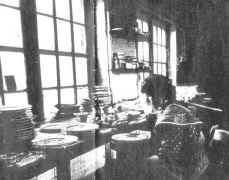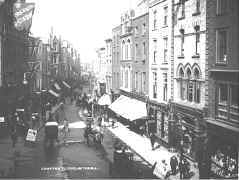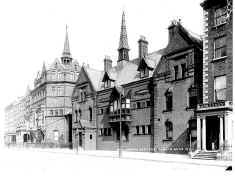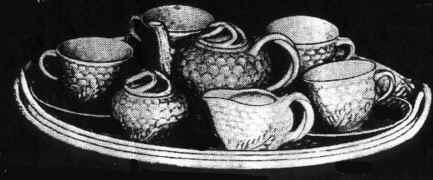


Prometheus's Fire - Sample Chapter(s): Ch19 (3)
The establishment of the Queen's Institute
Ireland had particular problems. The Great Famine in the late 1840s, although touching the peasantry most horrifically, had also had reverberations in the middle classes. Emigration had removed many men and changes in land ownership and the non-payment of rents resulting from the famine had left "numbers of well-born women" destitute. Many ladies were ready to help their less fortunate sisters and large numbers of them turned up at the conference as delegates. It was decided to establish a daughter Society for Promoting the Employment of women in Dublin which like its parent, would devote itself of the middle classes. On 19 August 1861 the Society for the Employment of Women opened its doors at 43 Grafton Street with Miss A.B. Corlett in charge (4).
Plate 19.3 : Contemporary Photograph of No 42, Grafton St. showing No. 43 at the edge of the frame ( Courtesy of the National Library of Ireland )
The initiating mind in this enterprise was the Quaker, Anne Jellicoe, the eventual founder of Alexandra College. She was the wife of a mill-owner and the daughter of a teacher and well aware of the relationship between effort and reward. While living in Mountmellick as a young married woman she had attempted to educate and train local girls as seamstresses and embroiderers. The disapproval of the Catholic Church proved too much and when the local parish priest, at the insistence of the bishop, personally broke up the school she allowed it to close (5). Shortly afterwards she moved with her family to Harold's Cross and there began investigating the living conditions of factory girls and the Dublin poor. Friends of Mrs Jellicoe always laid the credit for forwarding the crusade for the employment of middle class women at her feet. She was undoubtedly the leading spirit in the early days but shortly afterwards became involved in integrating girls into mainstream education through the founding of Alexandra College, and later, the school of the same name.
Plate 19.4 : Alexandra college, Dublin ( courtesy of the National Library of Ireland ; currently we only have the enlarged version)
However the woman who believed herself to be the leading light in the movement and who dominated its historical development and the institute that succeeded it, was Miss A. Barbara Corlett. She was the daughter of Henry Corlett, a coach spring manufacturer with business premises at 35 Frederick Street and who resided at 106 Summer Hill. He lived there from about 1846 until 1871 when he and his wife retired to 18 Leesson Street. Miss Corlett lived with her parent but was very active from the beginning in the Society. Certainly it would seem that Mrs Jellicoe's energies were soon put to the service of Alexandra College and the running of the Institute was left to Miss Corlett when it was established.
The first steps taken by the Dublin women followed the pattern established by the parent society in London. A registry was set up "to test the qualities of the applicants and to ascertain the wants of employers."(6) The results, while expected, were disappointing. The women who applied, the daughters of clergymen, country gentlemen, stipendiary magistrates, of civil servants and officers, "the most helpless class" of women, came armed with little more than "grotesque expectations". If anything their social pretensions were more deeply ingrained than those of the English ladies. Undoubtedly the political structures in Irish society at that time made an application for employment by a a lady from the Anglo-Irish gentry to a "low-born" Catholic/Gaelic merchant an exceedingly delicate, not to say, painful exercise. Mrs Jellicoe noted these endemic stresses with some impatience. When introduced to employers the ladies treated them with
"dignified patronage and took care to impress respect for their condescension in soliciting a salary, by declaring their ignorance of trade and hinting at a lofty contempt for traders."
The feeling that earning money was discreditable was rampant, and women declared that though glad enough to receive payment, their perceptions of delicacy were so refined that they would shrink from taking it openly, and required it to be conveyed to them in some secret and unusual way, which would prevent the disclosure of identity to the employer.
Mrs Jellicoe and Miss Corlett, both of whom had business in their blood, were not impressed and the ladies were berated for persisting in regarding labour as degrading and for not accepting that "the faculty of earning" was in itself "a respectable gift". It was evident that the situation would benefit neither supplicant lady nor seeking employer. The Committee brooded on the best method of turning a whole social class, burdened with history and expectations, into an efficient workforce. Should it follow the model of the mother organisation and concentrate its efforts on finding jobs for women and organising industries to employ them?
In the event this was not the course adopted in Dublin. That organisation was able to forward a solution that was much more sophisticated and far reaching. It may well have been the Dublin businessman, Henry Walker Todd, who hit on the best plan of campaign with his suggestion that the Dublin organisation should begin at the beginning and found what Miss Corlett and colleagues were to call a "Technical Training Institution for Women".
"It was with trembling delicacy" that the job applicants were approached with the suggestion that they attend a commercial class there to undergo a course of training in writing, dictating, arithmetic and bookkeeping. Indeed the committee itself had to set the ball rolling and make the course socially acceptable by enrolling themselves and their daughters for the first classes and paying the full fees. Only thus could they induce the sensitive Dublin ladies to cast aside their genteel doubts.
The next step was equally practical. A sewing machine class was set up, not to teach them how to become humble seamstresses but to train them as supervisors in textile factories. It was Anne Jellicoe's fond hope that not only would these women find "lucrative and honourable posts in this field but also that they would there find opportunities to introduce reform, where now the worst influences unhappily prevail."
By now the ladies on the committee were committed to the idea of an industrial college. In answer to a public appeal for funds to enable them to purchase a large house "in a desirable position" they were able to move to 25 Molesworth Street, making a brave beginning in two unfurnished rooms. The gracious patronage of Her Majesty and H.R.H. the Princess of Wales also persuade the Society to change its name to The Queen's Institute for the Training and Employment of Educated Women (7). The College had charitable status and was supported by donations from patrons, and, eventually, by grants from the Department of Education at South Kensington. It also enjoyed the backing of the Lord Lieutenant who was President, the Right Honourable Lord Talbot de Malahide, who was Vice President. Its treasurer was Mrs Lentaigne and its bank was the Royal at Foster Place. The objectives of the Society were clear:
This society has for its object to assist the ladies of limited means, by training them to the pursuit of professions and occupations, in which a demand is found to exist for their industry. It seeks to encourage parents to provide against contingencies, by giving to their daughters the means of independently providing for themselves, should they at any time be thrown upon their own exertions for support. With this in view, the following classes have been opened: Training Classes: Law Writer, Telegraph Clerks. Commercial Classes: Writing and dictation, Bookkeeping, Arithmetic, Overseer and Sewing Machine. Art Classes: Engraving on silver and ivory, Lithography, wood Engraving, colouring Photographs, Art and Architectural Drawing, Drawing on Wood, Wood and Metal Engraving and Scrivinery executed on moderate terms.Pupils under fifteen years of age cannot be received. Specimens of finely executed art work received from ladies for exhibition. Ten Shillings annually constitute the Subscriber a member of the Society; life subscription five pounds. Registry hours - eleven to one o'clock, Tuesday, Thursday, Saturday. Donations are respectfully solicited and will be received at the office by the Hon. Secretary, Miss A.B. Corlett or by the Royal Bank."
....................................................
Plate 19.5: Part of the Institute Tea set, probably designed for the Queen's Institute, and probably by the women students.
During these early years Mrs Jellicoe, whose husband had died in the early 60s, lived in the institute, leaving it eventually to become superintendent of Alexandra College at 9 Kenilworth Square - consequently leaving the way clear to Miss Corlett to impose her own ideas on the technical school. Before that, however, serious attempts had been made to create employment for trained women. A Scrivinery Office was established at the same address, as well as a shop selling stationery. It was called the Victoria Co-operative Association and was managed by Miss M.F. Gough. A more important boost to the institute came from the interest of one company, the British and Irish Magnetic Telegraph Company of its own accord, though possibly because of the numbers of influential patrons, offered the institute the necessary instruments for teaching the principles of the operation of the telegraph and even sent their principal engineer to instruct the class. In addition a weekly stipend was awarded to seven women chosen to be clerks while they were being trained. It was noted that the salary for this job was higher than in England, ranging from 10 to 15 shillings a week. In the first couple of years of the institute's existence seventeen clerks were trained in this manner.
Other classes were also offered with varying degrees of success. The most popular remained the textiles class, followed by the commercial classes. Law-writing, as in England, proved to be an area that women felt they could make their own and there were also students in lithography, engraving and woodworking. For a time the newly established Beleek pottery provided employment for women who learned the art of porcelain painting at the Queen's Institute. Woodwork of various kinds was another popular study. The telegraph class offered secure employment and there were even some few, probably aspiring governesses of the better type who were able to study Latin.

[ Enlarge ]
Plate 19.6: Women shown decorating a plate rim at Belleek Potteries.
The Royal Dublin Society, although slightly ambivalent in its attitude to the Queen's Institute provided initial support by opening its library to the ladies as well as its examinations for commercial certificates both to pupils at the institute as well as to other ladies.
During its first two years of existence the institute had 354 pupils of whom 180 found jobs. This figure improved to 464 in the third year. Over the next seven years 919 students attended the institute. Despite this high enrolment and its charitable status the institute was constantly hampered by lack of funds. Eventually it was decided to apply to the Science and Art Department of the Committee of Council on Education, South Kensington, for a grant to enable it to continue its programme of technical education. On 25 September 1868, Miss Corlett, in her capacity as secretary of the Institute, was examined by the Commissioners investigating the state of science education in the kingdom.
In her evidence Miss Corlett revealed the difficulties, other than financial, under which the Institute struggled. In the Art Department the women suffered from a lack of good staff to teach "the practice and technicalities of art and art products" as well as a museum of exhibits that would encourage improvement in art and design. Miss Corlett drew the attention of the Committee to the depressing fact that few women had the freedom to travel and study abroad so it was hardly surprising that their horizons remained constricted. Her solution to the problem was to suggest that the Education department of the Government set up a Department of Science and Art in Dublin.
The committee, of whom TH Huxley was a member, seemed to Miss Corlett tainted with a spirit of egalitarianism which struck her as quite alien. She insisted, regardless of the size of the grant that might be dangled, not only that the Institute would not run night classes because "we would not sanction such a thing as ladies attending a night school in Dublin. We would not incur such a responsibility on any account", but also that the Institute would only accept a certain sort of student, "We expect them to be gentlewomen . . . we would not take the daughters of servants or labourers." To the question "Would you take the daughters of tradespeople?", she replied, "Yes, but there are some trades we would not receive . . . we would not take the daughter of a man who kept a public house . . . But the daughter of any respectable trades, any person whom we could conscientiously consider unobjectionable, we would receive."(8)
In keeping with her restrained views on the mingling of different social classes, Miss Corlett attributed part of the Institute's success in finding employment for the ladies to the decorous attitude always displayed by the institute to the competition of the sexes in the market place. She informed the committee that the graduates of the Institute were in increasing demand, "the Queen's Institute has grown in public confidence, especially as we have never interfered with the pursuits of men - we are always unobtrusive."(9)
In her evidence Miss Corlett revealed something of a preference for the teaching of art as related to industry as well as a strong conviction that the social status of the students of the Queen's Institute was of paramount importance. It is undoubtedly significant that Miss Corlett's views on social rank and on what constituted an acceptable technical education for ladies were made public just at the time that the more egalitarian Anne Jellicoe was leaving Molesworth Street to become lady superintendent of Alexandra College.
As the Institute developed under the sole guidance of Miss Corlett, it divided into departments, at some remove from the aims of its original conception. By 1875, it purported to consist of three "separate" colleges with a writing agency attached. The brochure lists [1] Queens' Institute of Female Professional Schools; [2] Queen's College for the Education of Ladies; [3] Dublin Female School of Art; [4] Scrivenery and Order Office for Engraving, lithography, illuminating and portrait painting. The art side of the institute was in the hands of Herbert Cooper who remained there until its demise.
For a number of reasons, some of which were certainly financial (despite the fact that the Institute had by then been awarded grant status by the Department of Science and Art) and some of which probably related to the secretary's wish to improve the Institute's image and attract a wider clientele among the better-off of the Dublin middle classes, a great part of the original technical curriculum taught at the Institute was replaced by the standard school subjects, including those two tokens of a "ladylike" education, French and Music. Further emphasising the shift away from the technical and vocational streams, the Queen's College School for Young Girls was established and the combined institutions flowed over into 26 Molesworth Street, thereby undoubtedly adding to the financial burdens of the operation. By 1879, it had lost its charitable status and had become merely a seminary like the dozens of other similar ladies' establishments that were beginning to flourish in Dublin at this time.
On 18 October, 1880, Mrs Jellicoe died at her brother's house in Birmingham at the comparatively early age of 57. Many women's journals carried respectful obituaries to the woman who "was the apostle of employment as a means of salvation and elevation of women."10 Her funeral back in Dublin was a grand affair, and although she had remained a Quaker, it was attended by all the notables of the City, the Provost of Trinity College, the Lord Mayor, the President of the Queen's College and the Dean of St. Patrick. The archbishop of Dublin himself delivered the address and the remains were then transferred by train to the Friends' Burial Ground at Mountmellick.
Shortly afterwards in June 1881, Miss Corlett published a eulogy on the successes of the expanded Queen's Institute which included the description of herself as sole founder.11 Mrs Jellicoe, whose name had always previously been associated with the Institute and who had so recently passed away is not even accorded a cursory mention. After describing the glorious twenty year history of the school the author rises to a final peroration:
The founder has prepared a scheme for placing the technical and collegiate work on a permanent basis of great utility, in accordance with the Royal University organization, and with the liberal sentiments which are now permitted to guide the education of women.Among the faculties for which teaching is intended to be provided is that of medicine, and other chairs which are equally applicable to the capacity of women, and which by the appropriateness of fitness cannot but recommend themselves will be founded (sic).
This must have been wishful thinking because the Institute was in severe financial difficulties and enrolment numbers had dropped considerably. In addition the prominent citizens whose names had always been associated with the place appear to have withdrawn their support. Very shortly thereafter, the Queen's Institute ceased to exist and by 1883, 25 Molesworth Street had become vacant. The girls' school struggled on for another year before Buswell's Hotel took over the premises. Miss A.B. Corlett was listed as a ratepayer for the last time in 1882. Sadly some dark cloud of disgrace hung over her going. One assumes that she must have died soon afterwards but no obituary that I know of was written to honour her name or her efforts.
Some navigational notes: In most browsers, if you click on the 'Back' button, it will bring to to the point of departure in the document from which you came. Additional navigation options of local relevance are given at the foot of each page, thus:


